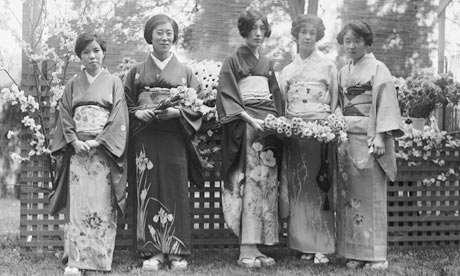
This is a small jewel of a book, its planes cut precisely to catch the light so that the sentences shimmer in your mind long after turning the final page. With The Buddha in the Attic, Julie Otsuka has developed a literary style that is half poetry, half narration – short phrases, sparse description, so that the current of emotion running through each chapter is made more resonant by her restraint.
She takes as her subject the Japanese women brought over in their hundreds to San Francisco as mail-order brides in the interwar period. Instead of a single, named protagonist, Otsuka writes in the first personal plural through a series of thematic chapters. Such a device shouldn't work but does. Although there are no dominant characters, Otsuka's brilliance is that she is able to make us care about the crowd precisely because we can glimpse individual stories through the delicate layering of collective experience.
The opening chapter sets the scene on the boat as the women make their crossing to America, clutching photos of the handsome young men they believe to be their new husbands. When they arrive, they are disillusioned by "the crowd of men in knit caps and shabby black coats waiting for us down below on the dock… the photographs we had been sent were 20 years old."
The reality that confronts the women deals a blow from which they never fully recover. In a devastating chapter entitled "First Night", Otsuka recounts the physical consummation of these new relationships. Some of the women's experiences are harrowing, some stilted, some humorous. Otsuka makes no distinction between them, relying on the rhythm of her words to pull the reader along. Occasionally a single voice will break through and the effect is startlingly good. "They took us by the elbows and said quietly, 'It's time.' They took us before we were ready and the bleeding did not stop for three days. They took us with our white silk kimonos twisted up high over our heads and we were sure we were about to die. I thought I was being smothered."
Each subsequent chapter charts some aspect of immigrant life – getting jobs, giving birth and dealing with the casual racism of pre-war America ("They learned that they should always call the restaurant first. Do you serve Japanese?"). Their children grow up to be more comfortable with their adopted land than their parents: changing their names to sound American and making fun of their mothers' accents. Some of the marriages survive and some don't.
And then, after Pearl Harbor, the order comes for the Japanese to be interned. Entire communities are uprooted, forced to give up their houses and livelihoods. It is here that Otsuka finally gives her women their names: "Iyo left with an alarm clock ringing from somewhere deep inside her suitcase but did not stop to turn it off. Kimiko left her purse behind on the kitchen table but would not remember until it was too late. Haruko left a tiny laughing brass Buddha up high, in a corner of the attic, where he is still laughing to this day."
This sudden individualisation is extremely poignant, especially when, in the final chapter, Otsuka's collective voice shifts from the Japanese to the Americans: "The Japanese have disappeared from our town. Their houses are boarded up and empty now."
Lyrical and empathetic, The Buddha in the Attic is a slender book of real, haunting power.

